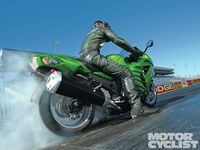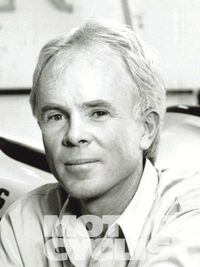"The Horsepower War Rages On!" That headline from a recent issue of Car and Driver magazine certainly snapped into focus. Motorcyclists who have been around for a while are used to the horsepower wars, or at least to the horsepower siege, a seemingly permanent struggle amongst the manufacturers to outdo each other in performance. Dual overhead cams were old hat to us long before the (domestic) car guys thought they might be important, and of course motorcycle acceleration is still completely out of reach of any road-going four-wheeler.
Still, this new automotive horsepower war looks pretty impressive at first glance. The Porsche 911 listed in the Car and Driver article made 381 bhp in 2006 and jumps to 620 in 2012 for a 63 percent gain in six years. The Chevrolet Corvette shows less gain, going from 505 bhp to 638, a 26 percent increase. A front-engined V12 Ferrari starts at 533 bhp and hits 700 in 2013 (it seems some of the 2012 cars are "officially" 2013s) for a 31 percent jump. The king in this group is the Mustang Shelby GT500, which had 300 bhp in 2006 and punches to 650 in '13 for a massive 116 percent gain.
The average is a 60 percent gain in that six-year gap. Cars like the Shelby Mustang are getting pretty wild, with the latest 650-bhp version boasting a 202-mph top speed.
Now let’s look at two bikes, 2006 to 2012. The new Kawasaki ZX-14R is making news with more than 190 bhp on the dyno. A good figure for a stock ’06 ZX-12R was 168 bhp, so the new bike shows an 18 percent increase in the six years for an average yearly gain of 3 percent.
Another newsmaker is the Ducati 1199 Panigale, claiming 195 bhp. Going back to ’06, Ducati was just about to phase out the 999, which claimed 148 bhp. The six-year gain is 32 percent and the average gain is 5 percent and change.
So with 3 percent added per year for the Kawasaki and 5-plus percent for the Ducati, it seems like the cars are really screaming with their 10-percent-per-year gains. But let’s look at weight: The 1199 Panigale is the lightest Ducati superbike ever with a claimed savings of 20 lbs. over the outgoing 1198. The Kawasaki, on the other hand, might be slightly heavier than the preceding model, but the pounds gained are minimal. Bikes are holding the line or even losing weight.
Cars are another story. Year-to-year weight gains may be relatively small, but these are cars that weigh between 1.5 and 2 tons each. After all, what all this horsepower is trying to do is move weight. How much weight does it have to move? Using the 650-bhp, 202-mph Mustang as a benchmark, the horsepower is trying to move 3850 lbs. That’s nearly 6 lbs. per pony.
The Ducati 1199 Panigale’s 387 lbs. is being urged along by 195 bhp, meaning that the equation gives just less than 2 lbs. per bhp. Admittedly, rider weight is a much bigger percentage of the total than driver weight in a car, but the Mustang, even with the current huge horsepower increases, will be carrying nearly three times the weight for each horsepower. No doubt these are excellent sports cars, and fun to drive. It’s just that this horsepower war is a regional conflict, limited to four wheels.
This really isn't news to motorcyclists. We know how bikes accelerate. So we also know that a "Horsepower War" amongst the cars is not going to threaten the fastest-accelerating road vehicles on the planet. Car and Driver's cover depicts the new 580-bhp Chevy Camaro ZL1. The cover of the Motorcyclist sitting next to it on my desk shows the aforementioned Kawasaki ZX-14R. Cover car quarter-mile? 12.3 seconds @ 119 mph. Cover bike quarter-mile? 9.3 seconds @ 151 mph. The more things change, the more they stay the same...












/cloudfront-us-east-1.images.arcpublishing.com/octane/QCZEPHQAMRHZPLHTDJBIJVWL3M.jpg)
/cloudfront-us-east-1.images.arcpublishing.com/octane/HXOUJXQWA5HBHGRO3EMJIGFMVI.jpg)

/cloudfront-us-east-1.images.arcpublishing.com/octane/3TIWWRV4JBBOLDVGRYECVVTA7Y.jpg)
/cloudfront-us-east-1.images.arcpublishing.com/octane/KIX5O23D5NAIBGFXBN3327DKZU.jpg)
/cloudfront-us-east-1.images.arcpublishing.com/octane/7GJYDUIPXRGMTMQKN6ONYOLBOU.jpg)
/cloudfront-us-east-1.images.arcpublishing.com/octane/MUQLOVLL2ZDGFH25ILABNBXKTI.jpg)
/cloudfront-us-east-1.images.arcpublishing.com/octane/TNOU5DNE2BC57MFPMGN2EIDXAM.jpg)
/cloudfront-us-east-1.images.arcpublishing.com/octane/GTCXACQGJ5HAPDTGWUQKDEH44E.jpg)
/cloudfront-us-east-1.images.arcpublishing.com/octane/S35YGSEMEZB4BLTDJTSZPF4GLA.jpg)
/cloudfront-us-east-1.images.arcpublishing.com/octane/5UOT6HPX2JFMRJAX6EH45AR4MQ.jpg)
/cloudfront-us-east-1.images.arcpublishing.com/octane/OKWOJWAKP5EP3OACCRRWPCIX2Q.jpg)
/cloudfront-us-east-1.images.arcpublishing.com/octane/2WF3SCE3NFBQXLDNJM7KMXA45E.jpg)
/cloudfront-us-east-1.images.arcpublishing.com/octane/G4MG6OUCJNBSHIS2MVVOTPX65E.jpg)
/cloudfront-us-east-1.images.arcpublishing.com/octane/IIGGWFOTOJGB7DB6DGBXCCMTDY.jpg)
/cloudfront-us-east-1.images.arcpublishing.com/octane/QSTCM6AVEZA5JJBUXNIQ3DSOF4.jpg)
/cloudfront-us-east-1.images.arcpublishing.com/octane/U4I7G625B5DMLF2DVIJDFZVV6M.jpg)
/cloudfront-us-east-1.images.arcpublishing.com/octane/B6XD6LS6IVCQPIU6HXDJSM3FHY.jpg)
/cloudfront-us-east-1.images.arcpublishing.com/octane/ICL63FEDDRDTTMINYICCEYGMDA.jpg)
/cloudfront-us-east-1.images.arcpublishing.com/octane/FCGZHQXRBZFLBAPC5SDIQLVF4I.jpg)
/cloudfront-us-east-1.images.arcpublishing.com/octane/WNOB6LDOIFFHJKPSVIWDYUGOPM.jpg)

/cloudfront-us-east-1.images.arcpublishing.com/octane/X33NU3E525ECRHXLNUJN2FTRKI.jpg)
/cloudfront-us-east-1.images.arcpublishing.com/octane/6KKT5NNL2JAVBOXMZYS5ZO76YA.jpg)